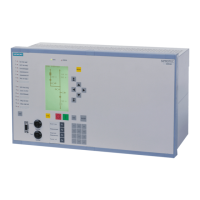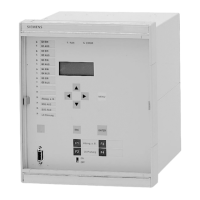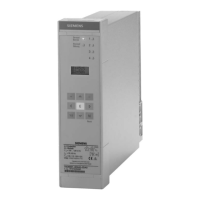Functions
2.5 Distance Protection
SIPROTEC, 7SD5, Manual
C53000-G1176-C169-5, Release date 02.2011
121
Pickup modes
The adaptation to different network conditions is determined by pickup modes.
The setting (PROGAM U/I) determines whether the phase–to-phase loops or the phase–to-earth loops are
always valid, or whether this depends on the earth fault detection. This allows a very flexible adaptation to the
network conditions. Optimum control mainly depends on whether the network neutral is not earthed (isolated
or compensated), has a low–resistance or effective earthing. Setting notes are given in Section 2.5.1.4.
The evaluation of phase–to-earth loops is characterized by a high sensitivity in the event of earth faults and is
therefore highly advantageous in networks with earthed
star points. It automatically adapts to the prevailing
infeed conditions; i.e. in the weak-infeed operation mode it becomes more current-sensitive, with high load cur-
rents the pickup threshold will be higher. This applies in particular if the network neutral is earthed low–resis-
tance. If only the phase-to-earth loops are evaluated, it must be ensured that the overcurrent stage Iph>> re-
sponds in the event of phase-to-phase faults. If only one measuring system picks up, it can be decided whether
this will result in a pickup of the phase-to-earth loops or the phase-to-phase loops in the earthed network (see
Table 2-5).
Table 2-5 Loops and phase indications for single-phase overcurrent pickup U/I; Phase-to-earth voltages
program
1)
Only active for earthed power systems
When evaluating the phase-to-phase loops, the sensitivity is particularly high for phase-to-phase faults. In ex-
tensive compensated
networks this selection is advantageous because it excludes pickup as a result of single
earth faults on principle. With two- and three-phase faults it automatically adapts to the prevailing infeed con-
ditions, i.e. in weak-infeed operation mode it becomes more current-sensitive, with strong infeed and high load
currents the pickup threshold will be higher. If only phase–to-phase loops are evaluated, the measuring loop is
independent of the earth-fault detection, therefore this procedure is not suitable for earthed networks
(see Table
2-6).
Table 2-6 Loops and phase indications for single-phase overcurrent pickup U/I; Phase-to-phase voltages
program
If the option has been chosen whereby voltage loop selection is dependent on earth-fault detection, then high
sensitivity applies to phase-to-earth faults and to phase–to-phase faults. On principle, this option is indepen-
dent of the treatment of the network neutral, however, it requires that the earth–fault criteria according to
Section Earth Fault Detection are met for all earth faults or double earth faults (see Table 2-7).
Pickup
Module
Measuring
Current
Measur-
ing
Voltage
Earth Fault
Detection
Parameter
1ph FAULTS
Valid
Loop
Alarmed
Phase(s)
L1
L2
L3
L1
L2
L3
L1-E
L2-E
L3-E
no
no
no
phase-to-
phase
L3-L1
L1-L2
L2-L3
L1, L3
L1, L2
L2, L3
L1
L2
L3
L1
L2
L3
L1-E
L2-E
L3-E
no
no
no
phase-to-earth
1)
L1-E
L2-E
L3-E
L1
L2
L3
L1
L2
L3
L1
L2
L3
L1-E
L2-E
L3-E
yes
yes
yes
any
L1-E
L2-E
L3-E
L1, E
L2, E
L3, E
Pickup
Module
Measuring
Current
Measur-
ing
Voltage
Earth Fault
Detection
Parameter
1ph FAULTS
Valid
Loop
Alarmed
Phase(s)
L1
L2
L3
L1
L2
L3
L1-L2
L2-L3
L3-L1
any any
L1-L2
L2-L3
L3-L1
L1, L2
L2, L3
L1, L3

